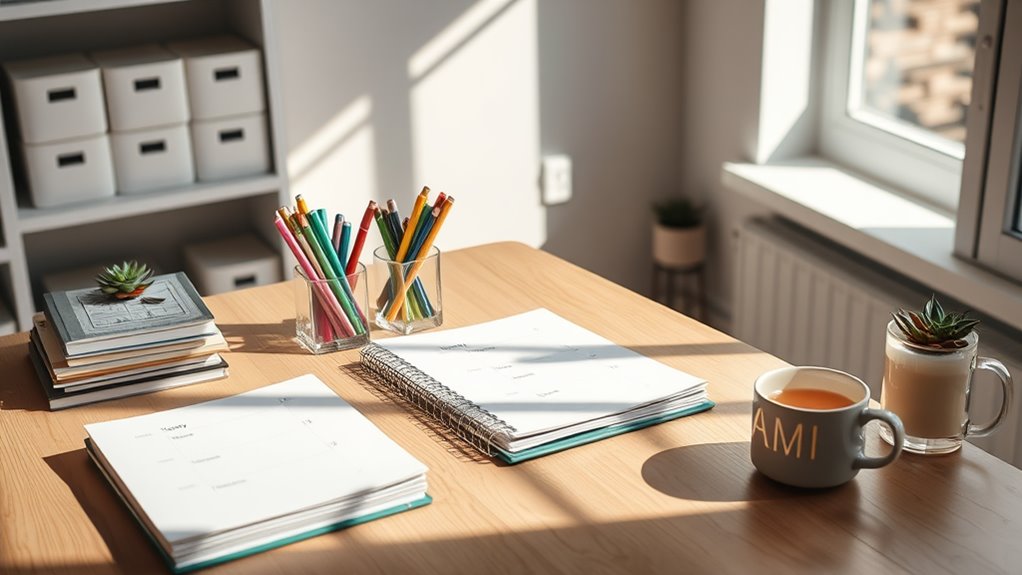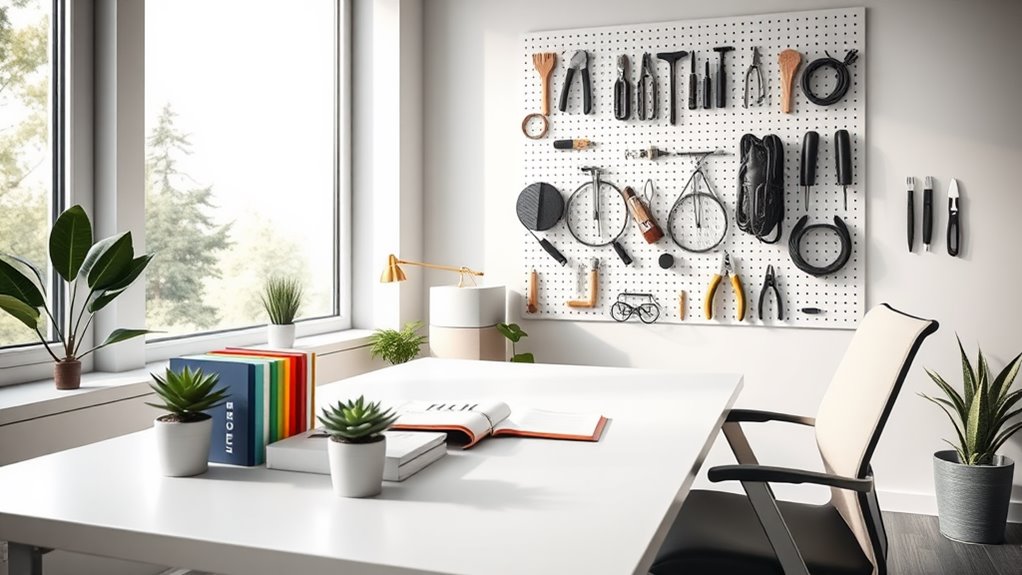The Ultimate Guide to Organizing Your Life No More Clutter!
Clutter can weigh you down, leading to stress and anxiety. To organize your life, start by adopting a minimalist mindset—keep only what’s essential. Categorize your belongings into keep, donate, or discard piles, and utilize vertical space with shelves. Streamline your daily routines with habits that save time, and implement consistent morning and evening rituals for structure. Enhance your mental clarity through mindfulness practices like meditation and journaling. Finally, commit to maintaining an organized lifestyle by setting aside weekly time to reassess your space. There’s much more to explore to find the balance you seek.
Key Takeaways
- Embrace minimalism by keeping only essential items and letting go of emotional attachments to clutter.
- Implement systematic decluttering by categorizing belongings into keep, donate, or discard.
- Establish daily routines and time-blocking techniques to streamline tasks and enhance efficiency.
- Incorporate mindfulness practices like meditation to boost mental clarity and reduce stress.
- Schedule regular maintenance sessions to reassess organization and prevent clutter from accumulating again.
Understanding Clutter’s Impact
Clutter can feel like a heavy weight pressing down on you, making it hard to focus or relax. Understanding clutter’s impact is essential for mastering your environment and your mind.
The concept of clutter psychology reveals how disorganization can affect your mental well-being. When you’re surrounded by disarray, it often leads to increased stress and anxiety. This chaotic space can inhibit your ability to think clearly and perform tasks effectively.
Emotional attachment plays a significant role in why you hold onto items. You might associate certain possessions with memories or experiences, making it difficult to let go.
This attachment can create a cycle of accumulation that exacerbates feelings of overwhelm. Recognizing these emotions is the first step toward addressing clutter’s toll on your life.
Decluttering Your Physical Space
Once you recognize how clutter affects your mental state, it’s time to take action and reclaim your space. Start by adopting a minimalist mindset; this approach encourages you to keep only what you truly need and love.
Begin in one area, such as your living room or bedroom, and tackle it systematically. Assess your belongings, and categorize them into three groups: keep, donate, or discard. Be ruthless—if you haven’t used it in the past year, it’s likely time to let it go.
Once you’ve decluttered, focus on shelves organization. Utilize vertical space effectively by installing shelves that not only store items but also showcase your favorite pieces. Organize items by category or frequency of use, placing everyday items within easy reach while storing less-used items higher up. Incorporate clear bins or labels to enhance visibility and accessibility.
Finally, maintain your newly organized space. Set aside a few minutes each week to reassess and tidy up. By committing to decluttering and embracing a minimalist mindset, you’ll cultivate a serene environment that enhances your productivity and peace of mind.
Streamlining Daily Routines
How can you transform your daily routines into a more efficient and stress-free experience? Start by focusing on habit formation. Identify the key tasks you perform each day, and assess their purpose. Eliminate unnecessary actions and streamline your process.
For instance, if you spend time deciding what to wear, consider creating a capsule wardrobe to reduce choices and decision fatigue.
Next, implement effective time management strategies. Use time-blocking techniques to allocate specific periods for tasks, ensuring you remain focused and productive. Set timers for 25-minute work sessions followed by short breaks to maintain energy and concentration.
This method fosters a rhythm that makes your day flow seamlessly.
Additionally, consider creating morning and evening routines. A consistent morning ritual prepares your mind for the day, while an evening routine helps you unwind and reflect.
By establishing these routines, you reinforce positive habits that enhance your overall efficiency.
Finally, track your progress. Regularly evaluate your routines and make adjustments as needed.
This ongoing process of refinement will help you master the art of streamlining your daily life, allowing you to enjoy greater peace of mind and increased productivity.
Enhancing Mental Clarity
To clear away mental fog, you need to prioritize activities that boost your focus and clarity. One effective approach is incorporating mindfulness practices into your daily routine. These techniques, such as meditation and deep breathing, help anchor your thoughts and enhance your overall awareness. By regularly engaging in mindfulness, you can greatly improve your cognitive benefits, leading to sharper focus and reduced anxiety.
Start by setting aside just a few minutes each day to practice mindfulness. Find a quiet space, close your eyes, and concentrate on your breath. This simple act can clear distractions and help you regain control over your thoughts.
Additionally, consider journaling as a way to articulate your thoughts and feelings. Writing can be a powerful tool to declutter your mind and clarify your goals.
Another effective strategy is to limit multitasking. Focus on one task at a time, and you’ll notice increased efficiency and better quality work.
Also, make sure you’re taking regular breaks to recharge your mental energy. By consciously steering your focus and cultivating mindfulness, you’re not just enhancing your mental clarity; you’re also setting the foundation for a more organized and productive life.
Maintaining an Organized Lifestyle
Building on the mental clarity you’ve cultivated, maintaining an organized lifestyle becomes much more achievable. To do this, you’ll need to focus on habit building and effective time management. Start by establishing daily routines that streamline your tasks. Consistency is key; the more you repeat these habits, the more automatic they’ll become.
Consider using tools like planners or digital apps to map out your day. Prioritize your tasks—identify what truly matters and allocate your time accordingly. This helps eliminate distractions and keeps clutter at bay. Set aside dedicated time each week for organizing your space, whether it’s decluttering your workspace or tidying your home.
Don’t forget about the power of reflection. At the end of each week, evaluate what worked and what didn’t. This practice will refine your strategies and reinforce your commitment to an organized lifestyle.
Frequently Asked Questions
How Do I Handle Sentimental Items While Decluttering?
Oh sure, keep every single item that tugs at your heartstrings! But really, prioritize memory preservation over emotional attachment. Choose a few treasures, photograph the rest, and let go with grace. You’ll feel lighter!
What Are the Best Tools for Organizing Digital Files?
To organize your digital files effectively, use cloud storage for easy access and backup. Implement consistent file naming conventions to enhance searchability. This structured approach simplifies retrieval and maintains order in your digital workspace.
How Can I Involve My Family in Decluttering Efforts?
To involve your family in decluttering activities, set clear goals together, assign tasks based on interests, and celebrate progress. Make it fun with challenges or rewards, ensuring everyone feels included and motivated throughout the process.
What Are Some Quick Tips for Organizing My Workspace?
Studies show that an organized workspace can boost productivity by up to 20%. Start by prioritizing desk essentials, optimizing your workspace layout, and removing distractions to create an efficient environment tailored to your needs.
How Do I Stay Motivated During the Decluttering Process?
Staying motivated during decluttering’s tough, but setting small goals helps. Celebrate your decluttering rewards, like a clean space or time saved. Use motivation strategies, such as visualizing your ideal environment, to keep pushing forward.


